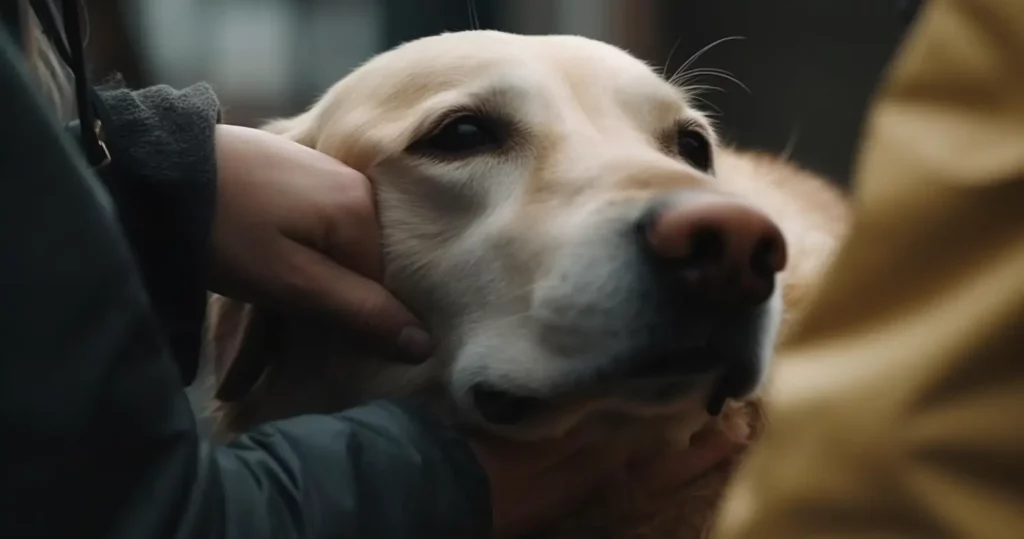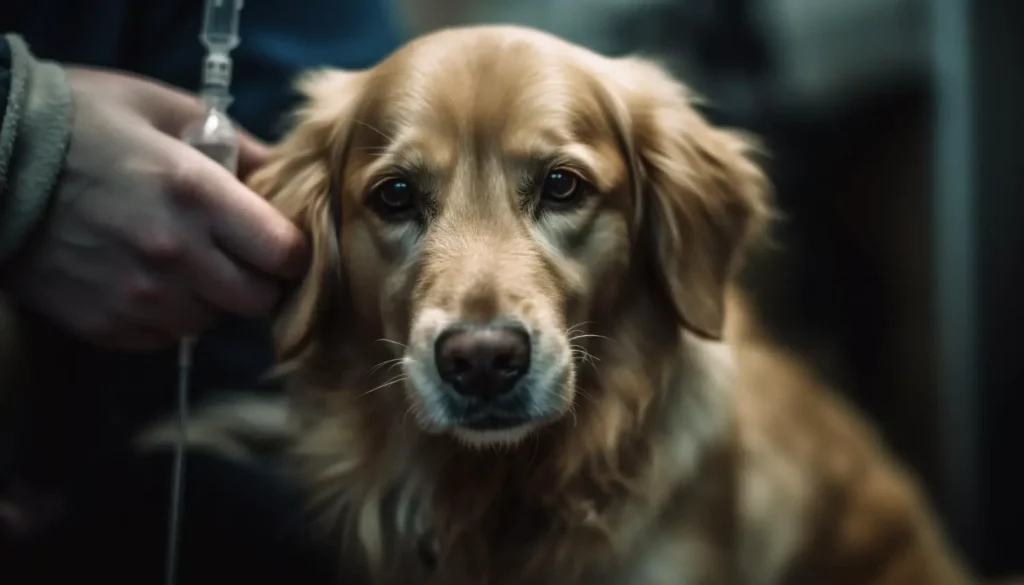How Long Can a Dog Live with a Ruptured Spleen?
Every pet owner’s priority is their dog’s well-being. An unforeseen health crisis, like a ruptured spleen, can create a wave of uncertainty and fear.
Understanding the details about how long can a dog live with a ruptured spleen, the treatment options, and what to expect can be a valuable tool in navigating these challenging times.
This blog post aims to do just that. Let’s dive in…
Key takeaways
A ruptured spleen in dogs is serious and needs immediate vet care.
Signs include weakness, rapid breathing, pale gums, and abdominal swelling.
Treatment usually requires surgery, possibly leading to spleen removal.
With proper care, dogs can have a good life after treatment, even without a spleen.
Regular vet check-ups can aid in early detection, improving the prognosis.
Unconditional love and care can significantly improve your dog’s life quality.
Short answer: a dog with a ruptured spleen can live a varying amount of time depending on factors like the cause of the rupture, whether surgery is performed, and the overall health condition of the dog. With prompt treatment, the prognosis can be improved, though some underlying conditions like cancer can affect this. It’s essential to consult with a vet for the best understanding of your dog’s individual situation.
Understanding the Canine Spleen
Just like in humans, the spleen in dogs plays an important role in maintaining overall health. It acts as a blood filter, removes old and damaged red blood cells, and acts as a storage unit for blood and platelets.
The spleen also plays a crucial role in a dog’s immune response, producing white blood cells to fight infections.
When the spleen is damaged or ruptured, it can lead to significant internal bleeding due to its rich blood supply. This is a medical emergency and requires immediate veterinary attention.
While a dog can technically live without a spleen, the removal of this organ, known as a splenectomy, leaves the dog more susceptible to infections.
In cases where the spleen is ruptured, whether due to an accident, an underlying health condition, or a tumor, immediate action is required. Rapid blood loss can lead to shock and even death if not treated urgently.
Understanding the signs, knowing what to do, and making the right treatment decisions can drastically affect how long a dog can live with a ruptured spleen.
Causes and Potential Risks
A ruptured spleen in dogs can occur due to a variety of reasons, each carrying its own set of risks and potential complications. One of the most common causes of spleen rupture in dogs is the presence of a spleen tumor.
These tumors, often hemangiosarcomas, are unfortunately common in certain dog breeds, including German Shepherds and Golden Retrievers. These tumors can grow undetected and may rupture, leading to sudden and severe internal bleeding.
Apart from tumors, another common cause of spleen rupture is trauma. This could occur due to accidents, such as falls or being hit by a car, which can cause the spleen to tear or burst. Severe blunt-force trauma can also cause a healthy spleen to rupture.
Finally, certain health conditions, such as splenic torsion where the spleen twists on its axis, can also result in a rupture. This condition is particularly common in large breed dogs with deep chests, such as Great Danes and Saint Bernards.
No matter the cause, a ruptured spleen is a critical emergency and warrants immediate medical attention. The outcome, including the life expectancy of a dog with a ruptured spleen, is dependent on the cause, the promptness of treatment, and the overall health of the dog.
It’s crucial to be aware of your dog’s health and monitor any sudden changes in behavior, as these could be indicative of underlying issues such as a spleen tumor or other health conditions.

Symptoms and Diagnosis
Detecting a ruptured spleen in dogs can be challenging due to the non-specific nature of the symptoms. Signs can range from subtle to severe, often depending on the rate of internal bleeding.
Common signs to watch out for include:
- Abdominal pain or swelling
- Weakness or lethargy
- Pale gums
- Rapid breathing or panting
- Collapse
In addition to these, dogs with spleen cancer may also show signs of weight loss, decreased appetite, and increased abdominal girth due to the accumulation of blood or fluid in the abdomen.
Diagnosing a ruptured spleen involves a thorough physical examination, diagnostic imaging such as X-rays and ultrasound, and laboratory tests.
Ultrasound is particularly useful as it can provide a detailed image of the spleen and help identify any tumors, blood accumulation, or other abnormalities. Blood tests can detect anemia, which is often present due to internal bleeding.
Early diagnosis is crucial in improving the prognosis and life expectancy of a dog with a ruptured spleen. If your dog exhibits any of the above symptoms, it is essential to seek veterinary care immediately.
Even in cases where spleen cancer is involved, early detection and treatment can make a significant difference in your dog’s quality of life and survival rate.
Managing a Ruptured Spleen
The moments after identifying a ruptured spleen in dogs are absolutely critical. Rapid blood loss can lead to shock, so it’s essential to act quickly.
As a pet owner, the initial steps you take can have a direct impact on your dog’s survival and recovery. If you notice signs of a ruptured spleen in your dog, it’s important to remain calm and seek emergency veterinary care immediately.
While rushing your dog to the clinic, try to minimize movement as much as possible to prevent further damage or bleeding. Keep your dog warm during the transit, as shock can make them feel cold.
Once at the clinic, your vet will first stabilize your dog by controlling the bleeding and providing fluids and blood transfusions if necessary. They may then perform diagnostic tests to confirm the cause and decide on the best course of treatment.
The dog spleen rupture survival rate greatly depends on how quickly the dog receives treatment, and the severity and cause of the rupture. Dogs that receive immediate care have a better chance of survival.
However, it’s important to remember that each case is unique, and survival rates can vary. The vet’s primary goal will be to stabilize your dog and provide the best possible treatment options for a good quality of life.
Euthanasia and Spleen Tumors
As a pet parent, the welfare of your four-legged family member is paramount. However, certain health conditions, like spleen tumors, can sometimes lead to complex, heart-wrenching decisions about euthanasia.
When a dog has a spleen tumor, it can often lead to a ruptured spleen. Hemangiosarcoma, a type of cancer commonly associated with spleen tumors, is aggressive and often advanced by the time of diagnosis. This can lead to a poor prognosis and a reduced life expectancy for the dog.
Euthanasia is never an easy decision to make, but it is sometimes the most compassionate choice to avoid unnecessary suffering. But when is the right time to make this difficult decision? It’s about assessing your dog’s quality of life.
Some questions to consider include:
- Is my dog still enjoying their favorite activities?
- Are they in pain that is not manageable with medication?
- Are they able to eat and drink comfortably?
- Can they move around without difficulty?
These questions can guide you toward making a decision that is in the best interest of your pet. It’s also crucial to have open and honest discussions with your vet about your pet’s condition, prognosis, and any concerns you may have.
They can provide valuable insight and advice based on their expertise and understanding of your dog’s specific condition. Remember, choosing euthanasia is about prioritizing your dog’s quality of life over quantity. It is an act of love, albeit a painful one, to spare your pet from unnecessary suffering.

Treatment Options and Prognosis
After a diagnosis of a ruptured spleen in dogs, treatment options often depend on the underlying cause. Surgery is typically required to control the bleeding and, if possible, repair or remove the damaged spleen. This surgery, known as a splenectomy, can often lead to an immediate improvement in your dog’s condition.
However, if a spleen tumor is the cause of the rupture, the prognosis can be more complicated. While the removal of the tumor can control the immediate threat of internal bleeding, it does not eliminate the risk of metastasis if the tumor is malignant.
Chemotherapy is often recommended following splenectomy in the case of malignant tumors to manage the disease’s spread. However, the prognosis can vary greatly, with dog spleen tumor life expectancy without surgery generally being very short.
With surgery and subsequent chemotherapy, life expectancy can be extended to several months or possibly more.
In cases where surgery isn’t an option due to your dog’s health or age, palliative care, which focuses on managing symptoms and maintaining the quality of life, is also an option. Pain management, nutritional support, and other forms of care can ensure your dog is comfortable and happy in their remaining time.
It’s essential to discuss these options in detail with your vet. Every dog is different, and the best treatment plan will depend on your pet’s overall health, age, and the specifics of their condition. Always remember that the goal of any treatment should be to provide your dog with the best possible quality of life.
Final Stages of Spleen Cancer in Dogs
Spleen cancer, especially hemangiosarcoma, is often a silent disease that can reach its final stages without showing any severe symptoms. When a dog reaches the final stages of spleen cancer, the signs can become more noticeable and distressing.
You might observe increased lethargy, loss of appetite, weight loss, and difficulty breathing. You might also notice a distended abdomen due to the accumulation of blood or fluid. As the disease progresses, your dog might collapse or go into shock due to internal bleeding from a ruptured tumor.
In these final stages, the focus of care often shifts towards palliative treatment. The goal is to maintain comfort and quality of life rather than cure the disease. Pain management becomes crucial, and your vet may prescribe medications to control pain and other symptoms.
There is no ‘one-size-fits-all’ approach to managing the final stages of spleen cancer in dogs. Decisions regarding treatment and care should be made in consultation with your vet, considering your dog’s overall health, comfort, and happiness.
It’s a challenging time, but your love and care can make a big difference in your dog’s life quality during these difficult days.
Post-Surgery Life and Care
After surviving a ruptured spleen, your dog isn’t just a pet – they’re a fighter. However, post-surgery care is crucial to ensure they can continue living a healthy, happy life. If your dog has undergone a splenectomy, it can still live a normal life.
However, since the spleen is part of the immune system, you may need to take some extra precautions to protect your dog from infections.
It’s vital to follow your vet’s post-operative care instructions closely. This may include wound care, medication administration, dietary changes, and the limitation of physical activities until your dog is fully healed. Regular check-ups will be necessary to monitor your dog’s recovery and to catch any potential complications early.
In the case of spleen tumors, further treatment like chemotherapy may be required. Regular follow-ups and scans are also crucial to monitor for signs of recurrence or metastasis.
Above all, lots of love and a comfortable, stress-free environment will go a long way in supporting your dog’s recovery. Remember, every day post-surgery is a gift – a testament to your dog’s strength and your commitment to their wellbeing.
Despite the challenges, dogs can indeed survive a ruptured spleen and continue to live fulfilling lives with proper treatment and care. The life expectancy after spleen removal in dogs depends on several factors, but with proper care, they can still enjoy a good quality of life.
Prevention and Early Detection
When it comes to a ruptured spleen in dogs, prevention isn’t always possible. Accidents happen, and diseases like cancer can strike without warning. However, early detection of issues can improve the prognosis and increase the dog’s spleen tumor rupture survival rate.
Regular vet check-ups are crucial for the early detection of health issues. Even if your dog seems perfectly healthy, routine examinations can catch underlying conditions before they become serious problems. Blood tests, ultrasounds, and physical examinations can all be useful tools for early detection.
At home, keeping a close eye on your dog’s behavior can also be beneficial. Changes in appetite, energy levels, or behavior can all be signs of underlying health issues. If your dog is a breed prone to spleen issues or is getting older, you may want to be especially vigilant.
While it might not be possible to prevent a ruptured spleen, knowing the risks and taking proactive steps toward early detection can make a significant difference in your dog’s life. Your vigilance, coupled with regular vet care, can ensure your dog lives a happy, healthy life.
Frequently Asked Questions
Is a ruptured spleen painful for a dog?
Yes, a ruptured spleen can cause severe pain in dogs. This is due to the internal bleeding and potential blood clots that can follow the rupture. Pain symptoms may include restlessness, loss of appetite, and apparent discomfort when moving or lying down.
What happens if a dog’s spleen ruptures?
When a dog’s spleen ruptures, it leads to internal bleeding. This can cause an array of symptoms such as weakness, rapid breathing, pale gums, abdominal pain or swelling, and even collapse. If left untreated, a ruptured spleen can quickly become life-threatening due to blood loss.
What causes a dog’s spleen to burst?
A dog’s spleen can burst due to trauma or injury, such as being hit by a car or a fall. It can also rupture due to medical conditions like splenic tumors, with hemangiosarcoma being the most common. In many cases, these tumors can grow undetected until they cause the spleen to rupture.
How long can a dog live with internal bleeding without surgery?
This can vary depending on the severity of the bleeding. However, untreated internal bleeding, like that from a ruptured spleen, is usually life-threatening within a few hours to a day. Immediate veterinary attention is necessary for survival.
Final Thoughts
The journey of dealing with a ruptured spleen in dogs is indeed a difficult one, packed with tough decisions and emotional challenges.
However, equipped with the knowledge, understanding, and professional veterinary support, you can navigate this difficult terrain with courage and compassion. Remember, the key lies in early detection, prompt treatment, and diligent post-surgical care.
Whether your dog is in the pink of health or dealing with a health condition, your love, care, and attention can make a world of difference in their lives. At the end of the day, our dogs don’t count their days; they make their days count.
So, let’s make every moment count for our furry friends!

![How to Get Dog Poop & Urine Smell Out of House and Carpet? [8 Easy Solutions]](https://www.warmlypet.com/wp-content/uploads/2023/01/How-to-Get-Dog-Poop-Smell-Out-of-House.webp)




